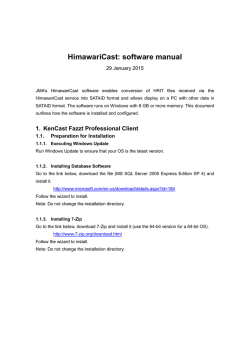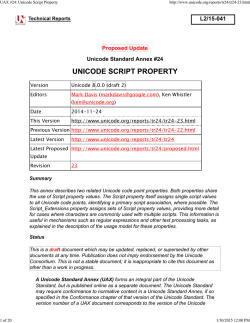
¡Hola! ¿Cómo te llamas?
RE1_08NATE_xxx ii-23.qxd 6/13/06 7:01 AM Page 2 Objectives Language Input • Greet people at different times of the day • Introduce yourself to others ¡Hola! ¿Cómo te llamas? VOCABULARY Core Instruction ¡Hola! ¿Cómo te llamas? • Respond to classroom directions • Begin using numbers • Tell time jcd-0099 • Identify parts of the body Standards: 1.2 Resources: Teacher’s Resource Book: Input Script, p. 6; Clip Art, pp. 17–21, Audio Script p. 7; Voc. and Gram. Transparency 21; Audio Program: Track 1 Focus: Presenting different ways to greet friends and adults in the morning, afternoon, and evening Suggestions: Use the Input Script from the Teacher’s Resource Book or the stories from the TPR Stories Book any time you have new vocabulary to introduce, or use other ideas that work for you. Show the transparencies to introduce the words. Be sure students notice the age differences of the speakers and the different times of day the conversations take place. When students have become familiar with the conversations, ask them to greet you and one another. Point out the Nota, and explain that these provide additional explanations and useful information. —¡Buenos días, señor! —¡Buenas tardes, señora! —¡Buenos días! ¿Cómo te llamas? —¡Buenas tardes! ¿Cómo te llamas? —Me llamo Felipe. —Me llamo Beatriz. —Mucho gusto. —Encantada. Nota A woman or girl says encantada. A man or boy says encantado. Exploración del lenguaje Exploración del lenguaje Señor, señora, señorita Core Instruction Focus: Explaining different ways to address others Suggestions: Write examples on the board such as Señor Trujillo and then write the abbreviation Sr. Trujillo. Point out the comparison in English to students. They may be surprised at the relative formality with which adults are addressed in Spanish. Have students identify school personnel with the new Spanish titles. —¡Buenas noches! ¿Cómo te llamas? —¡Hola! Me llamo Graciela. ¿Y tú? —Me llamo Lorenzo. —Mucho gusto. —Igualmente. The words señor, señora, and señorita mean “sir,” “madam,” and “miss” when used alone. When they are used with people’s last names they mean “Mr.,” “Mrs.,” and “Miss,” and are abbreviated Sr., Sra., and Srta. Note that the abbreviations are capitalized. In Spanish you should address adults as señor, señora, or señorita, or use the titles Sr., Sra., and Srta. with their last names. 2 dos En la escuela 2 Students with Learning Difficulties Advanced Learners If students have problems identifying individual phrases in context, provide them with a list of specific words and phrases that you want them to know. Model different ways in which they can combine the words and phrases for communication. Explain that ¿Cómo te llamas? and Me llamo... do not literally mean “What’s your name?” and “My name is...”. Use this as an opportunity to demonstrate that languages cannot be translated on a word-to-word basis. Some students may also benefit from further explanation of the Nota and of agreement of adjectives. ii-23.qxd 6/27/06 9:23 PM Page 3 jcd-0099 Escuchar Los nombres Buenos días Chicas Alicia Ana Beatriz Carmen Hablar Focus: Listening to understand greetings Gloria Suggestions: In all Escuchar activities, you may either play the Audio CD or read the script. Walk around the room to monitor comprehension and check that students are pointing to the correct clocks. Juana Luisa Margarita María Eugenia (Maru) ¿Recuerdas? Marta If you are a girl, you say encantada. Teresa (Tere) Chicos Alejandro Hablar Script and Answers: Luz María (Luzma) María tivid ad Ac Modelos A —¡Hola! ¿Cómo te llamas? B —Me llamo David. ¿Y tú? A —Me llamo Antonio. Mucho gusto. O: Encantado. B —Igualmente. Antonio (Toño) 1. —Buenas noches, Señor Rodríguez. —Hola, Roberto. (c) 2. —Buenas tardes, Alicia. —Buenas tardes, señora. (b) 3. —Buenos días, Señora Gómez. —Hola, Ana. (a) 4. —Buenos días, Pablo. —Buenos días, señor. (a) 5. —Buenas noches, Jorge. —Hola, María. (c) 6. —Hola, Juana. —Buenas tardes, Catalina. (b) Carlos (Chacho, Cacho) ¡Hola! Diego Eduardo (Edu) Federico (Kiko) Francisco (Paco) Modelos —Buenas tardes. —Buenas tardes. ¿Cómo te llamas? —Me llamo Paco. ¿Y tú? —Me llamo Lourdes. Mucho gusto. —Encantado. Guillermo (Guille) A B A B A Jorge José (Pepe) Juan Manuel (Manolo) Miguel Más práctica Pablo Practice Workbook, p. 1: P-1 tivid Standards: 1.1 ad Work with a partner. Choose a clock from Actividad 1 and greet each other appropriately for the time of day. Then find out your partner’s name. Follow the model. Change partners and repeat. ● Elena Isabel (Isa) Your teacher will divide the class in half. Students in one half of the class will introduce themselves and shake hands, and students in the other half will say they are pleased to meet the others. Move quickly from person to person until time is called. Then switch roles. 3 Script, p. 7; Audio Program: Track 2; Answers on Transparencies Inés ¿Cómo te llamas? AUDIO Dolores (Lola) 2 Focus: Practicing introductions Suggestions: Model a personalized version of the conversation with a volunteer and go over roles. Students will need to learn how to do paired practice. Point out that the ¿Recuerdas? boxes will remind students of things they’ve already learned. Pedro Ricardo For: Spanish Names Web Code: jcd-0001 Roberto tres 3 Para empezar Enrich Your Teaching Resources for All Teachers Culture Note Teacher-to-Teacher In Spain and many other Spanish-speaking countries, Buenos días is used until noon. Buenas tardes is used from noon until the evening meal. Buenas noches is considered both a greeting and a farewell. Bring in a kitchen timer and set it for the time you want to allot for each paired activity. When the bell rings, stop the activity, review the task with students if necessary, and move on. The timer will help you keep track of the time and will help students focus. tivid Standards: 1.1 ad Tomás Ac Ac ad 2 1 Resources: Teacher’s Resource Book: Audio Cristina tivid Standards: 1.2 tivid ad Listen as people greet each other. Then point to the clock that indicates the time of day when the greetings are probably taking place. a. b. c. Ac 1 Practice and Communicate Ac tivid ad Ac RE1_08NATE_xxx 3 Focus: Practicing greetings appropriate to time of day; asking and telling names Suggestions: If you wish, have students choose Spanish names to use in class. Allow students to repeat the activity with several partners. 3 RE1_08NATE_xxx ii-23.qxd 6/27/06 9:25 PM Page 4 Language Input ¡Hola! ¿Cómo estás? jcd-0099 ¡Hola! ¿Cómo estás? VOCABULARY Core Instruction Standards: 1.2 Resources: Teacher’s Resource Book: Input Script, p. 6, Audio Script, p. 7; Voc. and Gram. Transparency 22; Audio Program: Track 3 Focus: Introducing expressions used to ask and answer how someone is Suggestions: Use the transparencies and the dialogue to help students guess the meanings of the unfamiliar words in blue type. Direct attention to the ¿Recuerdas? Play the Audio CD or read the conversations beneath the pictures. Then role-play the conversations with students. Draw a rising sun at one end of the blackboard, a noontime sun a little to the right with a dividing line under it, a setting sun a little further to the right, and a moon at the far end. Position pairs of students at various points along the board, and have the class identify whether they would say Buenos días, Buenas tardes, or Buenas noches, depending on where they are. Point out that hasta + an expression of time means that you’re saying good-bye until that time. Bellringer Review Show Vocabulary and Grammar Transparency 22. Ask students to prepare a short dialog with a partner to represent one of the pairs of speakers pictured. (Cover the dialogs on the transparency.) —Buenos días, Adela. ¿Cómo estás? —Buenas tardes, Sr. Ruiz. ¿Cómo está Ud.? —Buenas noches, Miguel. ¿Qué tal? —Bien, gracias, Sr. Ruiz. ¿Y usted? —Muy bien, gracias. ¿Y tú? —Bien, gracias. —Regular. ¿Y tú, Carlos? ¿Qué pasa? —Bien, gracias. —¡Adiós, Srta. Moreno! ¡Hasta luego! —Nada. —¡Hasta luego, Juan! —¡Nos vemos! —¡Hasta mañana! ¿Recuerdas? Señor, señora, and señorita are abbreviated to Sr., Sra., and Srta. before a person’s last name. 4 cuatro En la escuela 4 Students with Learning Difficulties Heritage Language Learners Have students create a section in their notebook for vocabulary and a separate section for grammar. For each chapter, students can enter new vocabulary and grammar concepts into their respective sections. Allow students to accompany vocabulary words with pictures and English translations, as needed. Many students who already speak Spanish may have little or no formal experience with the written language. Ask these students to write new versions of the dialogues above, personalizing them in some way. Have them pay special attention to spelling. You can use this exercise to informally assess their written Spanish. RE1_08NATE_xxx ii-23.qxd 6/27/06 9:29 PM Page 5 Practice and Communicate Exploración del lenguaje Tú vs. usted Would you say tú or Ud. when talking to the following people? • your brother • your teacher • your best friend • your friend’s mother • your cat • your principal • a new acquaintance who is your age Escuchar Leaving Standards: 1.2 tivid ad 1. 2. 3. Greeting 4 AUDIO Resources: Teacher’s Resource Book: Audio Script, p. 7; Audio Program: Track 4; Answers on Transparencies tivid Focus: Listening to understand greetings ad Ac Resources: Answers on Transparencies Suggestions: Tell students to use Ud. for anybody that they call by their last name. Answers: 1. tú; 2. usted; 3. tú; 4. usted; 5. tú; 6. usted; 7. tú Make a chart on your paper with two columns. Label one Greeting, the other Leaving. Number your paper from 1–8. As you hear each greeting or leave-taking, place a check mark in the appropriate column next to the number. 5 Hablar ¡Hola! ¿Qué tal? Work with a partner. Greet each other and ask how your partner is. Say good-bye. Then change partners and repeat. tivid ad Ac Standards: 4.1 jcd-0099 ¿Hola o adiós? 6 ANSWERS Core Instruction Ac 4 Exploración del lenguaje Suggestions: Draw the chart on the board as a model. Modelos —Hola, Luisa. ¿Qué tal? —Bien, Lupe. ¿Y tú? —Regular. ¡Hasta luego! —¡Adiós! Script and Answers: A B A B 1. 2. 3. 4. 5. 6. 7. 8. Leer Mucho gusto 1. The people knew each other. Profesor: 3. We know the last names of both people. Buenos días. Me llamo José Guzmán. ¿Y tú? 4. The student talks to the teacher in a formal tone. Estudiante: Me llamo María Hernández. Mucho gusto. Profesor: 2. The teacher is a man. Igualmente. ¿Cómo estás, María? 5. Neither person is feeling well today. Estudiante: Bien, gracias. ¿Y Ud.? Profesor: Más práctica Muy bien, gracias. Hasta luego. ● Hola, Juan. ¿Qué pasa? (greeting) Adiós, Miguel. (leaving) Buenos días, señor García. (greeting) Hola, Elena. (greeting) Nos vemos. (leaving) Hasta mañana, señor Pérez. (leaving) Buenas noches, señora. (greeting) Hasta luego, Ana. (leaving) Standards: 1.1 tivid ad Read the conversation and then reply sí or no to the statements. Ac tivid ad Ac For most Spanish speakers there are two ways to say “you”: tú and usted. Use tú when speaking to friends, family, people your own age, children, and pets. Usted is formal. Use it to show respect and when talking to people you don’t know well, older people, and people in positions of authority. In writing, usted is almost always abbreviated Ud., with a capital U. 5 Focus: Using greetings Suggestions: Have students switch roles with one asking and one answering. Practice Workbook, p. 2: P-2 Enrich Your Teaching Resources for All Teachers Standards: 1.2, 1.3 tivid ad cinco 5 Para empezar Ac Estudiante: Adiós, señor. 6 ANSWERS Resources: Answers on Transparencies Focus: Reading comprehension Suggestions: If the answer is “No,” have students provide correct information. Culture Note Teacher-to-Teacher Answers: In Spain, a newborn child is generally given a first name, no middle name, and two surnames — one from each parent. Usually, the father’s surname is first and the mother’s surname is second. This is different in the United States, where a child is given a first name, perhaps a middle name, and one last name, usually the father’s surname. To keep students on task and speaking Spanish during a paired activity, circulate and place star stickers on the desks of students who are participating. Give the stars a value—three stars equals a bonus point, for example. When using this system, remind students that stars can be taken away for not participating or for speaking English. 1. no 2. sí 3. sí 4. sí 5. no Additional Resources WAV Wbk.: Audio Act. 1, p. 1 Teacher’s Resource Book: Audio Script, p. 7, Communicative Act. BLM, p.11 • Audio Program: Track 5 • • 5 RE1_08NATE_xxx ii-23.qxd 6/13/06 7:05 AM Page 6 Language Input ¡Atención, por favor! jcd-0099 ¡Atención, por favor! VOCABULARY Core Instruction Standards: 1.2 Resources: Voc. and Gram. Transparency 23; Teacher’s Resource Book: Audio Script, p. 7; Audio Program: Track 6 Focus: Presenting common classroom commands tivid —¡Silencio, por favor! Abran el libro en la página 10. —¡Atención! Cierren el libro. —Repitan, por favor: Buenos días. —Buenos días. Standards: 1.2 ad Ac Suggestions: Play the Audio CD or refer to the text under the pictures. Dramatize the classroom commands while saying them aloud or playing the CD. Have students guess the commands. Then say them again and have the class respond as asked. Try to do as much classroom management in Spanish as possible. 7 AUDIO Resources: Teacher’s Resource Book: Audio —Siéntense, por favor. —Levántense, por favor. Script, p. 7; Audio Program: Track 7; Answers on Transparencies Focus: Listening and responding to classroom commands Abran el libro. (open the book) Levántense. (stand up) Repitan: Buenas tardes. (repeat) Siéntense. (sit down) Cierren el libro. (close the book) Saquen una hoja de papel. (take out a sheet of paper) Extension: Provide additional commands for the students: Pasen a la pizarra. Trabajen en parejas. Cierren la puerta. Abran la ventana. 6 Ac 7 jcd-0099 Escuchar ¡Siéntense! You will hear some classroom commands. Listen carefully and act them out. Script and Answers: 1. 2. 3. 4. 5. 6. tivid ad Suggestions: Play the Audio CD or read the script. Have students simply listen the first time. Then play or read the script again, having students act out the commands. —Saquen una hoja de papel. Escriban los números. —Entreguen sus hojas de papel. 6 seis En la escuela Students with Special Needs Advanced Learners For students who find the commands difficult to act out, have them discuss with you other ways they might indicate comprehension of the commands. Depending on the students, these might include simple hand or arm movements. Have students turn to p. 100 in their textbook and then flip through the pages, randomly stopping ten times. They should say or write the page number each time they stop. Point out that the numbers are written out on each page. ii-23.qxd 6/13/06 7:06 AM Page 7 Practice and Communicate jcd-0099 Los números 10 diez 21 veintiuno, . . . 30 treinta 31 treinta y uno, . . . 11 once 12 doce cero uno dos tres 13 trece 14 catorce cuatro 15 quince 16 dieciséis 17 diecisiete 18 dieciocho seis siete ocho nueve Ac 8 10 Hablar Resources: Voc. and Gram. Transparency 24; 80 ochenta 90 noventa Teacher’s Resource Book: Audio Script, p. 8; Audio Program: Track 8 100 cien Tell your partner these numbers in Spanish. He or she will write them using numerals, not words. Then check your partner’s work. 5. 14, , 16 ,8 6. 17, , 19 3. 7, ,9 7. 23, , 25 8. 29, , 31 , 12 2. the bar code number on the back of your Spanish book 3. your house or apartment number tivid ad 9 8 ANSWERS 1. dos 2. siete 3. ocho 4. once 5. quince 6. dieciocho 7. veinticuatro 8. treinta 4. number of minutes it takes you to get from your home to school Pensar/Hablar Más números 1. 1, 2, 3, . . . 10 4. 5, 10, 15, . . . 60 2. 2, 4, 6, . . . 20 5. 3, 6, 9, . . . 39 3. 1, 3, 5, . . . 19 6. 10, 20, 30, . . . 100 tivid Standards: 1.1 ad Ac 5. number of months until your next birthday With a partner, provide the missing numbers in each sequence. Then say the number sequence aloud in Spanish. 9 ANSWERS Resources: Answers on Transparencies Focus: Practicing with numbers Suggestions: Make sure students understand that each sequence represents a pattern. They have to identify the pattern before they can provide the missing numbers. Answers: Más práctica ● Standards: 1.1 Resources: Answers on Transparencies Focus: Reading numbers Suggestions: Have students read the entire sequence, not just the answer. Answers: Practice Workbook, p. 3: P-3 For: Los números Web Code: jcd-0002 1. 2. 3. 4. Azulejo (tile) de cerámica siete 7 Para empezar cuatro, cinco, seis, siete, ocho, nueve ocho, diez, doce, catorce, dieciséis, dieciocho siete, nueve, once, trece, quince, diecisiete veinte, veinticinco, treinta, treinta y cinco, cuarenta, cuarenta y cinco, cincuenta, cincuenta y cinco 5. doce, quince, dieciocho, veintiuno, veinticuatro, veintisiete, treinta, treinta y tres, treinta y seis 6. cuarenta, cincuenta, sesenta, setenta, ochenta, noventa Enrich Your Teaching Teacher-to-Teacher Give each student a number written large on a piece of paper. Have them tape the numbers to their shirts. Then have the class stand in a circle and clap their hands rhythmically. The student who is uno says his or her number and then calls out another number. The student who has that number says it, then calls out another number (e.g., “¡uno, diez!”; diez then responds, saying “¡diez, cuatro!”). All the while, students clap the rhythm. If someone makes a mistake, the person and number are out. tivid Standards: 1.1, 1.3 ad Resources for All Teachers Ac Ac 4. 10, 1. the phone numbers used to dial for information and emergencies tivid ad Supply the missing number. Then read the sequence in Spanish. ,3 Suggestions: Have students practice numbers by playing bingo or by rolling number cubes. Hablar/Escuchar/Escribir Números y más números 2. 6, Standards: 1.2 60 sesenta 70 setenta Los números 1. 1, VOCABULARY Core Instruction tivid ad tivid ad Ac cinco 19 diecinueve 20 veinte 40 cuarenta 50 cincuenta Los números Ac RE1_08NATE_xxx 10 Focus: Using numbers Suggestions: Verify answers using a transparency. Answers will vary. Additional Resources • Teacher’s Resource Book: Communicative Activity BLM, pp. 14–15 7 RE1_08NATE_xxx ii-23.qxd 6/13/06 7:07 AM Page 8 Language Input ¿Qué hora es? VOCABULARY ¿Qué hora es? jcd-0099 In Spanish, to ask what time it is, you say ¿Qué hora es? Here are some answers: Core Instruction Standards: 1.2 Resources: Voc. and Gram. Transparencies 25–26; Teacher’s Resource Book: Audio Script, p. 8; Audio Program: Track 9 Es la una. Son las dos. Son las tres y cinco. Son las cuatro y diez. Son las cinco y cuarto. Son las seis y media. Son las siete menos veinte. Son las ocho cincuenta y dos. Focus: Telling time Suggestions: Show the transparencies for telling time. Ask: ¿Qué hora es? Point to a clock, and have students tell you the time. Mark different times on the transparency. ad Ac Standards: 1.1 tivid 11 tivid ad Activity: Show Transparency 25. Have students number 1–8 on a sheet of paper. As you point to each clock, make true/false statements. Have students write C (Cierta) or F (Falsa) to respond. • Pre-AP* Resource Book: Comprehensive guide to Pre-AP* skill development, pp. 9–53 • Ac Pre-AP* Support 11 Hablar ¿Qué hora es? Modelos Work with a partner to ask and answer questions about the time. Use these clocks. 1. 2. 5. 6. A —¿Qué hora es? B —Son las diez. 3. 4. ANSWERS Resources: Answers on Transparencies Focus: Asking and telling the time 12 tivid jcd-0099 12 Escuchar La hora Write the numbers 1–8 on a sheet of paper. Write the times you hear with numerals—1:00, 2:15, and so on. Standards: 1.2 tivid ad Ac treinta; 3. Es la una y cuarto / quince; 4. Son las dos y veinte; 5. Son las nueve y cuarenta. / Son las diez menos veinte; 6. Son las doce y cincuenta. / Es la una menos diez. ad Answers: 1. Son las siete; 2. Son las tres y media / Ac Suggestions: Point to the classroom clock and prompt students to say what time it is. AUDIO Resources: Teacher’s Resource Book: Audio Script, p. 8; Audio Program: Track 10; Answers on Transparencies Focus: Listening to understand time of day Más práctica ● Practice Workbook, p. 4: P-4 8 ocho “La persistencia de la memoria / The Persistence of Memory” (1931), Salvador Dalí Oil on canvas, 9 1/2 x 13 in. (24.1 x 33 cm). Given anonymously. © 2004 Salvador Dalí, Gala-Salvador Dalí Foundation/Artists Rights Society (ARS), New York.† A.K. En la escuela Suggestions: When the activity is complete, repeat each time of day again and ask volunteers for the answers. Script and Answers: 1. Es la una y media. (1:30); 2. Son las diez. (10:00); 3. Son las once y cinco. (11:05); 4. Son las doce. (12:00); 5. Son las seis y media. (6:30); 6. Son las siete y cuarenta y cinco. (7:45); 7. Son las nueve y veinte. (9:20); 8. Son las tres y treinta y cinco. (3:35) Teaching with Art Resources: Fine Art Transparencies with Teacher’s Guide, p. 16 8 Students with Learning Difficulties Advanced Learners Some students may be unable to read clocks with faces and hands. If so, provide times on digital clocks. Have students write a television program guide with the names and times of their favorite programs. Suggest that they use the newspaper listings as a model. Have students exchange program guides. One student will say a time, and the other student will say the name of the program. RE1_08NATE_xxx ii-23.qxd 6/13/06 7:08 AM Page 9 El cuerpo Language Input jcd-0099 la cabeza el ojo El cuerpo Core Instruction la nariz VOCABULARY Standards: 1.2 Resources: Voc. and Gram. Transparency 27; la boca Teacher’s Resource Book: Audio Script, p. 8; Audio Program: Track 12 Focus: Presenting vocabulary for parts of the body el brazo la mano tivid “ ad el estómago Ac el dedo ¡Ay! Me duele el pie ” . jcd-0099 13 Suggestions: Play the Audio CD and show the transparency. Pretend to be in pain and say: ¡Ay! Me duele el pie. Continue with the rest of the vocabulary. Note that only singular body parts are used. Point out the use of the article to refer to body parts. Escuchar Ac ad tivid 14 el pie la pierna Escuchar Juego Play the game Simón dice . . . (Simon Says). Listen and follow the leader’s directions. Remember that if the leader does not say “Simón dice,” you should not do the action. Más práctica Practice Workbook, p. 5: P-5 WAV Wbk.: Writing, p. 4 ● Guided Practice: Vocab. Flash Cards, Vocab. Check, Grammar Act., pp. 1–10 ● Real. para hispanohablantes, pp. 2–3 Standards: 1.2 tivid ad You will hear some commands. Listen carefully and act out the commands. When you hear the word señalen, you should point to that part of the body. Ac Señalen 13 AUDIO Resources: Teacher’s Resource Book: Audio Script, p. 8; Audio Program: Track 13 Focus: Listening comprehension of commands Suggestions: Play the Audio CD or read the script, twice. Suggest that students listen the first time and perform the action the second time. Script and Answers: 1. 2. 3. 4. 5. 6. Señalen la nariz. (nose) Señalen el estómago. (stomach) Señalen la mano. (hand) Señalen la cabeza. (head) Señalen el pie. (foot) Señalen el brazo. (arm) ● nueve 9 Para empezar Enrich Your Teaching Standards: 1.2 tivid ad For: El cuerpo Web Code: jcd-0003 Ac ● 14 Focus: Listening and responding to directions Suggestions: Have students take turns playing leader in small groups. Answers will vary. Resources for All Teachers Additional Resources Teacher-to-Teacher Have students create a poster of a “creature” using images cut from magazines or newspapers. Their creature can have six arms, four legs, etc. Have them label each of the WAV Wbk.: Audio Act. 2, p. 1 Teacher’s Resource Book: Audio Script, p. 8 • Audio Program Track 11 • body parts. Provide plurals as necessary. Display the art in the classroom and ask students trueor-false questions about each one, or have them list the body parts that they see. • Assessment • • Quiz Prueba PE-1: En la escuela, p. 8 9
© Copyright 2024




